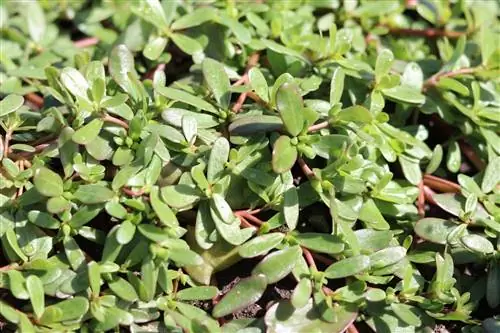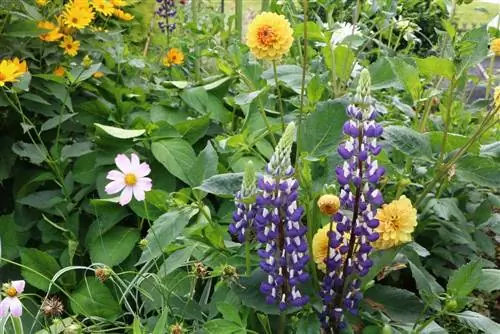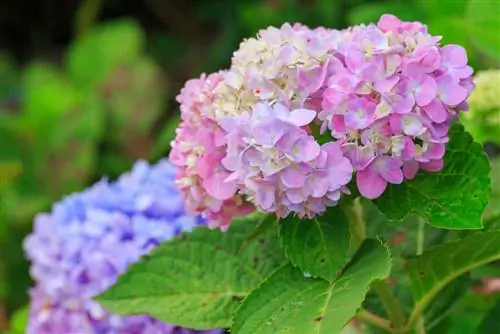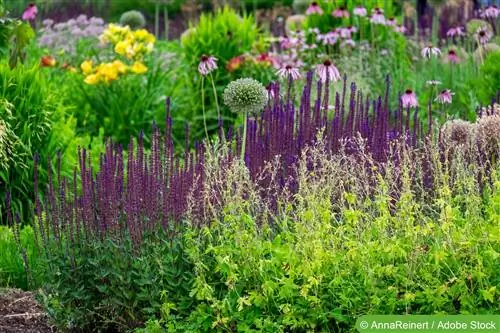- Author admin [email protected].
- Public 2023-12-17 03:39.
- Last modified 2025-06-01 06:48.
The purslane or Portulaca oleracea is quite unknown in local gardens. It is a very he althy wild vegetable that can be grown quite easily and even cultivated indoors. Decried as a weed in some fields, it enriches the local cuisine. In order for the leafy vegetables to really thrive, they need the right care.
Fresh and raw on a salad, to help with heartburn or steamed as a leafy vegetable - purslane is a versatile herb. And widely underestimated. With its high content of vitamin C, iron, magnesium and essential fatty acids, it is a he althy addition to many dishes and is even ideal for cold cuisine. Not only is the preparation easy, the cultivation is also easy to carry out with the right measures. This applies to the garden bed as well as to the windowsill in the house.
Location
A weed in some places, purslane is not picky about location. The plant thrives particularly well in a sunny spot, but it can also tolerate light shade. The location does not have to be protected.
Tip:
The more sun the purslane receives, the faster and more luxuriantly it will grow.
Companion plants
The Portulaca oleracea, especially in the wild form, can pose a danger to surrounding plants. There can also be competition from other plants. However, the following are well suited as companion plants:
- Radish
- Radish
- Kohlrabi
- Turnip
- Rocket / Rocket
- Plucking lettuce
- Corn
- Strawberries
Substrate
As a substrate, purslane prefers nitrogen-rich, loose soils. Regular garden or potting soil mixed with sand and prepared with a nitrogen-based fertilizer is ideal. The Portulaca oleracea, however, does not need many nutrients, so it can be in poor soil - as long as the nitrogen content is slightly higher.
Pouring
The purslane can survive dry periods, but its leaves are not particularly fleshy. Therefore, the more you water, the juicier the harvest. Even short-term waterlogging cannot harm the medicinal plants. You can use the watering can often and abundantly. However, the floor should not constantly “float”.
Fertilize
If you have chosen fresh soil and prepared it with nitrogen before planting, you can forego the following fertilization. It is crucial that the soil quality is correct, but additional nutrients are not necessary. If the harvest is poor or the soil is already a little worn out, a small amount of compost can be added.
Sowing
It is not necessary to grow the seeds indoors and can be done directly in the bed from May onwards. The following should be noted:
- Sow the seeds in thin rows
- Maintain at least 20 cm distance between plants and rows
- As a light germinator, only cover thinly with substrate
- Pay attention to light and consistent humidity
- Do not cover
Portulaca oleracea can also be grown indoors all year round. The only requirements here are that the temperature does not fall below 10 °C, the location is sunny and warm.
Tip:
Reseeding after two weeks is recommended to ensure a continuous harvest.
Purslane as a weed
The purslane grows very quickly - the fresh leaves can be harvested for the first time after just three to four weeks. After six weeks, the plants can already scatter seeds. Within a very short time, it is possible for wild vegetables to spread over larger areas and then become competition for other plants. To prevent this, it is recommended to limit the bed. A small, close-meshed fence or a tarpaulin drawn all around is sufficient for this purpose. Alternatively, Portulaca oleracea can also be grown in larger pots with the edge providing demarcation.
Harvest
The harvest, as already mentioned, can begin very quickly after sowing. The time has already come the first month after the application. The upper leaves are harvested, the lower leaves remain and ensure that new crops are sprouted again. The only limitation is the flowering period. As soon as the first flowers appear, the leaves of Portulaca oleraceas become unpleasantly bitter. As the plant ages, it also becomes fibrous and tough. It is better to sow several times and only harvest the young plants each time - instead of just the old plants throughout the entire season.
Wintering
Purslane is not frost hardy, so if you want some of it beyond the warm season, you have to bring it indoors in good time. It can still survive outdoors up to a temperature of 10 °C, but actual harvesting is no longer possible. The plant does better at a normal room temperature of 18 °C to 25 °C. If it is watered abundantly, it will continue to thrive quickly and luxuriantly as usual. A window seat is necessary.
Unlike the plant itself, the seeds can survive the winter in the ground, so if you don't want uncontrolled spread or don't plan to continue growing purslane, you should take appropriate steps in good time. On the one hand, it helps not to plant the plants directly in the bed. A raised bed or container is ideal. Alternatively, seed formation can simply be prevented by removing the flowers before they wither.
Tip:
The flowers of the purslane can be used in the kitchen like capers.
Typical diseases and pests
The only thing that can really be dangerous to purslane in the garden are snails, which primarily feed on the young leaves. Snail fences and appropriately secured raised beds can help here. Purslane, however, is resistant to diseases and other pests. When caring for it, care should be taken to ensure that no persistent waterlogging occurs. Because Portulaca oleracea is not completely immune to root rot.
Frequently asked questions
Should preference be given to wild or cultivated forms?
The cultivated form of purslane is up to 30 cm taller overall and produces larger leaves, which makes harvesting easier. It also spreads less quickly. The wild form is smaller and has smaller leaves, but is more resilient. It spreads and suppresses any competing companion plants. Which form is preferred is a question of individual circumstances and conditions.
Are there risks of consuming purslane?
Portulaca oleracea is generally used for complaints in the gastrointestinal tract, such as heartburn and diarrhea, so it also has a healing effect. As with all medicinal plants, consumption should therefore be limited. Because excessive intake - especially over a longer period of time - can lead to undesirable side effects and intolerances.
What you should know about purslane in brief
The plant, also known as spice purslane, should not be confused with the purslane (Portulava grandiflora), this colorful and richly blooming summer flower for the balcony and garden.
- The summer purslane is an annual, herbaceous and succulent plant.
- It grows up to 40 cm high and branches heavily.
- Its region of origin can no longer be proven.
- The plant is now widespread worldwide except for the polar regions.
The rapid propagation (seedlings grow up within 6 weeks, bloom and then start spreading seeds again), the longevity of the seeds (50% still germinate after 14 years) as well as their swimming ability and seawater resistance contributed to this. The purslane prefers a sunny and wind-protected place.
- The plants are very adaptable and cope well with most types of soil.
- They grow best in light, sandy and humus-rich soil.
- They hardly require any care in the garden. Potted plants need to be watered regularly.
Usage
The summer purslane has been used for nutrition for several thousand years, but, like most wild vegetables, has been somewhat forgotten. Young leaves taste slightly sour, s alty and nutty, while older leaves taste bitter. The leaves of the purslane contain large amounts of vitamin C and omega-3 fatty acids and smaller amounts of vitamins A, B and E, the minerals and trace elements magnesium, calcium, potassium, iron, zinc as well as alkaloids, flavonoids, coumarins, saponins, glutamic acid, Oxalic acid and the sterol beta-sitosterol. Purslane can provide relief from heartburn, gastritis, and constipation. In addition, deficiency diseases are prevented.
- The flower buds, harvested between May and June, can be used as false capers.
- The shoots, leaves and stems before flowering can be eaten raw as a salad,
- cut into small pieces as a seasoning for quark, vegetables, spinach and soups.
- Thanks to its slimy consistency, purslane has a thickening effect.






